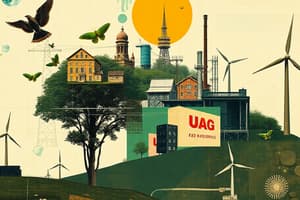Podcast
Questions and Answers
What does sustainability practice aim to ensure?
What does sustainability practice aim to ensure?
Meeting current needs without compromising future generations.
Which of the following is NOT a key principle of sustainability?
Which of the following is NOT a key principle of sustainability?
- Urbanization (correct)
- Renewable energy sources
- Sustainable agriculture
- Reduce, reuse, recycle
Biotic factors include non-living elements such as water and soil.
Biotic factors include non-living elements such as water and soil.
False (B)
Which of the following is an effect of climate change?
Which of the following is an effect of climate change?
The process of capturing and storing atmospheric CO2 is known as ___ sequestration.
The process of capturing and storing atmospheric CO2 is known as ___ sequestration.
Name one strategy to conserve biodiversity.
Name one strategy to conserve biodiversity.
What is the purpose of environmental policy?
What is the purpose of environmental policy?
Pollution negatively affects ecosystems and species.
Pollution negatively affects ecosystems and species.
What role do keystone species play in an ecosystem?
What role do keystone species play in an ecosystem?
Flashcards are hidden until you start studying
Study Notes
Sustainability Practices
- Definition: Approaches that meet current needs without compromising future generations.
- Key Principles:
- Reduce, reuse, recycle: Minimize waste through efficient resource use.
- Sustainable agriculture: Practices such as crop rotation and organic farming.
- Renewable energy sources: Wind, solar, and hydropower to reduce fossil fuel reliance.
- Green building: Energy-efficient buildings using sustainable materials.
- Community Involvement: Local initiatives promoting sustainable practices (e.g., community gardens).
Ecosystem Dynamics
- Components:
- Biotic factors: Living organisms (plants, animals, microorganisms).
- Abiotic factors: Non-living elements (water, soil, climate).
- Interactions:
- Food webs: Energy transfer through trophic levels (producers, consumers, decomposers).
- Succession: Changes in ecosystem structure over time (primary and secondary succession).
- Balance: The role of keystone species in maintaining ecosystem integrity.
Environmental Policy
- Purpose: Framework for managing human impacts on the environment.
- Types of Policies:
- Regulatory: Laws and regulations aimed at pollution control (e.g., Clean Air Act).
- Economic: Incentives for sustainable practices (e.g., carbon taxes, subsidies).
- International agreements: Treaties like the Paris Agreement addressing global environmental issues.
- Stakeholders: Government agencies, NGOs, private sector, and community groups.
Climate Change Impact
- Causes:
- Greenhouse gas emissions from fossil fuels, deforestation, and industrial processes.
- Effects:
- Temperature rise: Global warming leading to extreme weather events.
- Sea level rise: Melting ice caps and thermal expansion affecting coastal areas.
- Ecosystem shifts: Altered habitat ranges and species extinction risks.
- Mitigation Strategies:
- Emission reductions: Transition to renewable energy and energy efficiency.
- Carbon sequestration: Techniques to capture and store atmospheric CO2.
Biodiversity Conservation
- Importance: Essential for ecosystem health, resilience, and providing ecosystem services.
- Threats to Biodiversity:
- Habitat destruction: Urbanization, agriculture, and deforestation.
- Pollution: Chemicals and waste affecting ecosystems and species.
- Invasive species: Non-native organisms disrupting local ecosystems.
- Conservation Strategies:
- Protected areas: National parks and reserves to safeguard habitats.
- Restoration ecology: Rehabilitating degraded ecosystems.
- Legislation: Laws like the Endangered Species Act to protect vulnerable species.
Sustainability Practices
- Definition involves meeting present needs while ensuring future generations can meet theirs.
- Key principles include reduce, reuse, recycle to limit waste and promote resource efficiency.
- Sustainable agriculture techniques, such as crop rotation and organic practices, enhance soil health and biodiversity.
- Renewable energy sources like wind, solar, and hydropower are crucial for decreasing dependence on fossil fuels.
- Green building focuses on creating energy-efficient structures with sustainable materials.
- Community involvement fosters local sustainability initiatives, including community gardens, to encourage environmental stewardship.
Ecosystem Dynamics
- Components include biotic factors (living organisms) and abiotic factors (non-living elements such as water and soil).
- Food webs illustrate energy flow through different trophic levels, including producers, consumers, and decomposers.
- Ecosystem succession involves gradual changes in structure, categorized as primary (starting from bare substrate) and secondary (following disturbance).
- Keystone species play a critical role in maintaining ecosystem balance and integrity.
Environmental Policy
- Purpose is to manage human activities impacting the environment effectively.
- Types of policies include regulatory measures, which enforce pollution controls, exemplified by the Clean Air Act.
- Economic policies incentivize sustainability, such as carbon taxes that encourage reductions in emissions through financial mechanisms.
- International agreements, like the Paris Agreement, unify global efforts to tackle pressing environmental issues.
- Stakeholders in environmental policy encompass government agencies, non-governmental organizations (NGOs), the private sector, and local communities.
Climate Change Impact
- Key causes of climate change involve greenhouse gas emissions stemming from fossil fuel combustion, deforestation, and industrial activities.
- Effects of climate change include increased global temperatures triggering extreme weather events.
- Sea level rise poses threats to coastal regions due to melting ice caps and thermal expansion of oceans.
- Ecosystem shifts result in altered habitats and greater risks of species extinction.
- Mitigation strategies focus on reducing emissions, transitioning to renewable energy sources, and enhancing energy efficiency.
- Carbon sequestration methods aim to capture and store atmospheric CO2, contributing to climate stabilization.
Biodiversity Conservation
- Biodiversity is critical for maintaining ecosystem health and resilience, providing essential services like pollination and nutrient cycling.
- Major threats to biodiversity include habitat destruction from urban development, agriculture, and deforestation.
- Pollution poses serious challenges, with chemicals and waste products harming ecosystems and species diversity.
- Invasive species disrupt local ecosystems, often outcompeting native organisms.
- Conservation strategies include establishing protected areas such as national parks and reserves to shield habitats from development.
- Restoration ecology aims to rehabilitate degraded ecosystems, returning them to a more natural state.
- Legislation, including the Endangered Species Act, serves to protect vulnerable species from extinction threats.
Studying That Suits You
Use AI to generate personalized quizzes and flashcards to suit your learning preferences.




